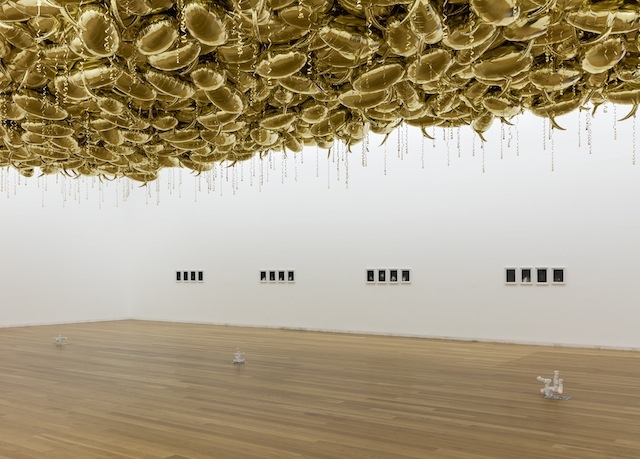Serralves Museum of Contemporary Art, Porto, 3 February – 7 May 2017
‘We are in a big building, and an event is taking place,’ reads the opening of Philippe Parreno’s 1995 book Snow Dancing, a speculative narrative for a party yet to occur. In recent years, the French artist’s megaprojects have folded architecture and event into a singular form. He has long mentioned an unrealised project to adapt Mary Shelley’s Frankenstein (1818) into a feature film; meanwhile he has birthed exhibitions as benevolent monsters, suturing artworks together to animate gigantic building-beings.
At Serralves – as, for example, at the Palais de Tokyo in 2013 – Parreno has been given the entire museum as his vessel, but here the baroque grandeur of his recent exhibitions has taken a turn towards spectral minimalism, foregrounding timbre rather than intensity, absence over action. Repeating and rearranging serial works across the museum’s 15 main spaces, this retrospective of sorts is rendered a landscape of eternal recurrence, as an electrical storm of pulsating lights and synthetic noise rolls through the galleries.
Like a mute chorus, over 200 of Parreno’s Fireflies (2012–16) align on many walls, black drawings defining an insect in scratchy ink amidst gloopy washes, upon what is often revealed to be hotel letterhead. With the aura of a nocturnal fever dream, the fireflies bear silent witness. Their bioluminescence seems stolen by the galleries’ flickering lights, their multitude the product of Parreno emulating the automaton of his 2007 film, The Writer.
Over 10,000 Speech Bubbles (1997–) nestle statically against the galleries’ ceilings. Different colours in each room, they form the sparse show’s main event, sometimes acting as lighting gels to tint whole spaces. From power outlets continually sprout the domestic apparatus of Parreno’s AC/DC Snakes (1995–2010) – small agglomerations of plugs and travel adaptors, often topped by nightlights – or his clear glass Happy Ending lamps (2014–16). Phosphorescent prints from Fade to Black (2004–13) punctuate walls, their images indiscernible in the daylight, while a smattering of his Christmas trees, Fraught Times: For Eleven Months of the Year it’s an Artwork and in December it’s Christmas (2008–16), idle inside and outside the museum, awaiting seasonal transformation. An illuminated ceiling and moving wall, sculptural offspring of Parreno’s scenography for Dancing Around the Bride (2012), perform a pas de deux in another space.
The more Parreno’s works are iteratively multiplied, the more they shed their visibility, and the architecture of the Álvaro Siza-designed museum asserts its own in their place. Freshly empowered to palpably breathe – its lighting and sound fluctuating like respiration – the museum assumes the foreground as an active landscape controlled by incorporeal forces; a building-scale ecosystem populated by a few flocks of different species of artwork, who engage in a silent conversation against an atmosphere of noise.
The conductor of this living museum is an artificial intelligence attempting to master Dmitri Shostakovich’s Fugue no. 24 in D minor (1950–1). In the auditorium a Disklavier piano plays the results, erudite musical phrases collapsing into pointillistic staccato as it ‘learns’. Inverting the master/slave relationship between silent cinema and piano accompaniment, a generative visualisation of the AI’s learning process is projected as the 3D ‘film’, A Time Coloured Space (2017), from which the exhibition takes its title. Plugged into the building’s infrastructure, beyond the auditorium, the fractured fugue dictates the rhythms of light, noise and window blinds of galleries under the algorithm’s electroacoustic possession. Whereas the yeast controller for Parreno’s 2016 Turbine Hall commission seemed half-hidden in a janitorial cupboard, at Serralves, signposted by one of the artist’s marquees, the project’s ‘brain’ has here literally moved to centre stage.
That the mechanics of the exhibition’s control both name it and are given such a platform seems a significant marker in Parreno’s work: a logical development of his increasing withdrawal as puppetmaster in favour of the delegation of exhibition choreography to designed systems. As the ‘brains’ of Parreno’s projects become increasingly sovereign, the artworks of the exhibition-monster appear less like its organs, more like an autonomous ensemble cast, awaiting direction. At Serralves it’s Parreno’s quasi-objects that now appear to be the participants in the event in a big building, the public eavesdroppers on their quiet communion.
First published in the April 2017 issue of ArtReview
